Imagine this—you pull a perfectly roasted ribeye from the oven, its golden-brown crust crackling slightly as you carve into the juicy, tender meat. The rich aroma fills the air, and your guests lean in, eager for that first bite. If you’re searching for a show-stopping dinner, this ribeye roast recipe is exactly what you need.
But here’s the thing—cooking the perfect ribeye roast isn’t just about throwing it in the oven. It’s about choosing the right cut, seasoning it well, and cooking it to perfection. This guide will walk you through everything you need to know about making the best ribeye roast recipe—from picking the best meat to ensuring a juicy, tender bite every time.
Let’s dive in!
Table of Contents
What is a Ribeye Roast?
A ribeye roast comes from the same flavorful rib section as prime rib, but there’s a key difference—it’s usually boneless and slightly smaller. This makes it easier to handle while still delivering that rich, beefy taste we all love.
So, what makes a ribeye roast special?
- Rich marbling – The fat streaks melt during cooking, keeping the meat juicy and flavorful.
- Tender texture – Since it comes from a less-worked muscle, it’s naturally soft.
- Bold beefy taste – Perfect for roasting because it enhances its deep flavors.
Pro Tip: If you want an extra juicy roast, choose a ribeye with good marbling—the more intramuscular fat, the better the flavor!
Ribeye Roast vs. Prime Rib: Are They the Same?
One of the most common questions people ask is:
Is a ribeye roast the same as a prime rib roast?
Not exactly. While they come from the same section, there are some key differences:
| Feature | Ribeye Roast | Prime Rib |
|---|---|---|
| Bone | Usually boneless | Bone-in (adds extra flavor) |
| Size | Smaller, around 3-5 lbs | Larger, often 6-12 lbs |
| Texture | Slightly firmer but still tender | Extra juicy due to the bone |
| Cooking Method | Roasted at lower temps | Often slow-roasted or reverse-seared |
If you’re looking for a leaner, more manageable roast, ribeye is your best bet. But if you love bone-in flavor, prime rib is also fantastic. And if you have leftovers, you can turn them into a mouthwatering steak sandwich for the next day!
Looking to explore more beef options? Check out our ultimate beef pepperoni guide for another delicious way to enjoy beef!
Is Ribeye Good for Roasting?
Absolutely! Ribeye is one of the best cuts for roasting because:
✔ It retains moisture – Thanks to its rich fat content.
✔ It’s naturally tender – No need for long marination or slow-cooking.
✔ It cooks evenly – Especially if it’s boneless.
However, there’s one mistake many people make: overcooking it. Ribeye roast shines at medium-rare to medium temperatures (more on that later). Similar to a smoked meatloaf, low-and-slow cooking helps keep it incredibly moist and flavorful..
Pro Tip: If you want a ribeye roast that melts in your mouth, low and slow is the way to go. Cooking at a lower temperature allows the fat to slowly render, creating an irresistibly juicy and tender texture.
How to Choose the Best Ribeye Roast
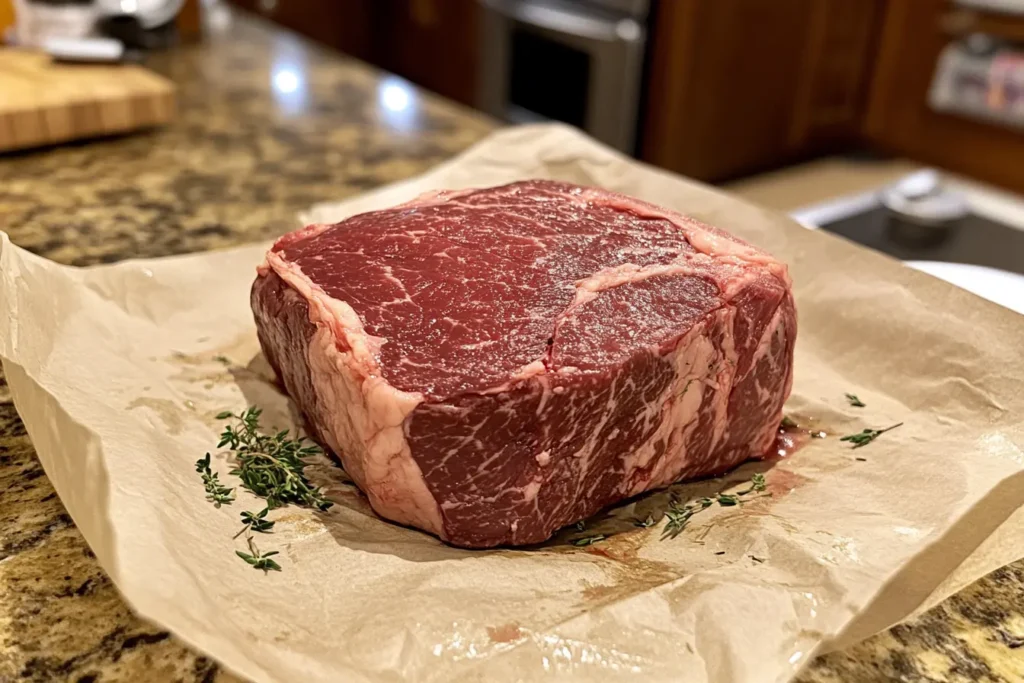
Not all ribeye roasts are created equal. When buying one, look for:
1. Bone-in vs. Boneless
- Boneless – Easier to carve, cooks faster.
- Bone-in – Adds more flavor but takes longer to cook.
Chef’s Tip: If you’re a beginner, go for a boneless ribeye roast—it’s easier to handle.
2. Best Quality and Grade
You’ll see labels like USDA Choice or USDA Prime when buying beef. Here’s what they mean:
- USDA Prime – Best quality, highest marbling, most flavorful (but pricier).
- USDA Choice – Still excellent, slightly less marbling, more affordable.
- USDA Select – Leaner, not ideal for roasting due to less fat.
For the best ribeye roast recipe, go for USDA Prime or high-end Choice.
3. How Much Ribeye Roast Per Person?
A good rule of thumb:
- ½ pound per person if serving with lots of sides.
- ¾ pound per person if it’s the main dish.
- 1 pound per person for big eaters or leftovers.
Example: A 4-pound ribeye roast serves 5–6 people comfortably.
Preparing Your Ribeye Roast for Cooking
1. Should You Sear a Ribeye Roast Before Cooking?
This is a big debate among home cooks. Some swear by searing first, while others prefer reverse searing (searing at the end).
So, should you sear before roasting?
✔ Yes! Searing locks in juices and enhances the crust.
✔ But… You can also reverse-sear for an even crispier crust.
Best Method: Sear the roast in a hot skillet (cast iron works best) before roasting.
2. Seasoning Ideas for Maximum Flavor
A simple seasoning blend works best for ribeye roast. Here’s what you need:
- 2 tbsp kosher salt (draws out moisture for a crispy crust)
- 1 tbsp black pepper (adds depth and mild heat)
- 1 tbsp garlic powder (brings out natural beefy flavors)
- 1 tsp rosemary or thyme (for an earthy touch)
- 1 tbsp olive oil (helps seasoning stick)
Pro Tip: Rub the seasoning at least 1 hour before cooking (or overnight for deeper flavor).
3. How Long to Let the Meat Rest Before Cooking?
You should always let the ribeye roast sit at room temperature for about 45-60 minutes before cooking.
Why?
✔ Cooks evenly – Cold meat takes longer to cook inside.
✔ Juicier texture – The fibers relax, making it more tender.
The Best Cooking Methods for Ribeye Roast
So, you’ve chosen a high-quality ribeye roast, seasoned it well, and let it rest. Now comes the most critical part—cooking it to perfection.
There are three main ways to cook a ribeye roast:
1. Slow Roasting (Best for Even Cooking)
This method involves cooking the roast at a low temperature (225°F-250°F) for a longer time.
✔ Pros: Super tender, evenly cooked, and juicy.
✖ Cons: Takes longer.
2. High-Temperature Roasting (For a Quick Cook)
Here, you cook the roast at a higher temperature (375°F-450°F) to form a crust quickly.
✔ Pros: Faster cook time, good crust.
✖ Cons: Risk of drying out if not monitored carefully.
3. Reverse Searing (Best for a Perfect Crust and Juicy Center)
This involves slow-roasting the meat first, then searing it at high heat at the end.
✔ Pros: Best crust and juiciness combination.
✖ Cons: Requires extra steps.
Pro Tip: The reverse sear method is the best way to achieve a perfectly cooked ribeye roast. It prevents overcooking while still developing a flavorful crust.
Oven Roasting: Step-by-Step Guide
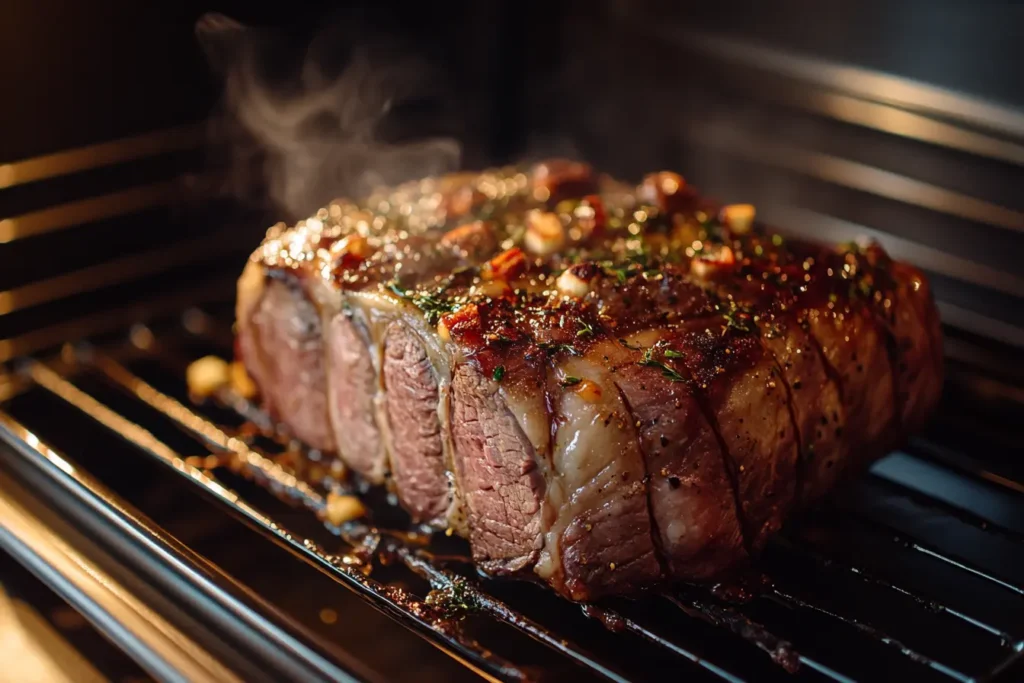
Now that you know the cooking options, let’s go with the best method—reverse searing. Follow this foolproof step-by-step recipe to achieve a perfect ribeye roast every time.
Ingredients You’ll Need
| Ingredient | Quantity |
|---|---|
| Ribeye roast (boneless or bone-in) | 3-5 lbs |
| Kosher salt | 2 tbsp |
| Black pepper | 1 tbsp |
| Garlic powder | 1 tbsp |
| Fresh rosemary (optional) | 1 tsp |
| Fresh thyme (optional) | 1 tsp |
| Olive oil | 2 tbsp |
| Unsalted butter | 2 tbsp |
Step 1: Preheat the Oven
Set your oven to 225°F (107°C). A lower temperature ensures even cooking and prevents drying out.
Step 2: Season the Ribeye Roast
- Pat the roast dry with a paper towel.
- Rub the olive oil all over the meat.
- Generously coat with salt, black pepper, and garlic powder.
- Add fresh rosemary and thyme for extra flavor.
- Let it sit for 30 minutes to absorb the seasoning.
Step 3: Roast Low and Slow
- Place the ribeye roast on a wire rack over a baking sheet.
- Insert a meat thermometer into the thickest part.
- Roast at 225°F until it reaches 10-15°F below your target doneness.
Pro Tip: Cooking low and slow ensures the roast stays tender and evenly cooked.
Step 4: Rest the Meat
Once the roast reaches the desired temperature (see doneness chart below), remove it from the oven and let it rest for 30-45 minutes.
Why?
✔ Allows juices to redistribute.
✔ Prevents moisture loss when slicing.
Never skip resting time—it makes all the difference!
Step 5: Sear for the Perfect Crust
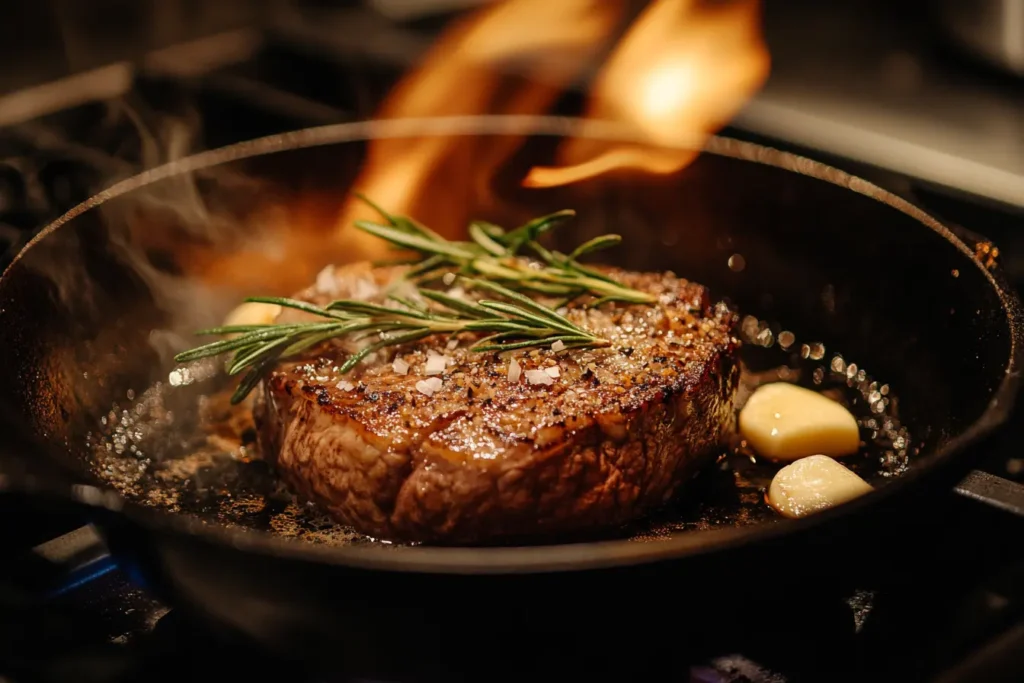
- Heat a cast-iron skillet over high heat.
- Melt 2 tbsp of butter in the pan.
- Sear the roast on all sides for 30-60 seconds per side until a beautiful golden-brown crust forms.
Step 6: Slice and Serve
- Use a sharp knife to slice against the grain.
- Serve immediately with your favorite side dishes.
Block Quote:
“Cooking a ribeye roast is all about patience. A slow roast followed by a quick sear gives you that unbeatable combination of tenderness and a crispy crust.”
Cooking Time and Temperature Guide
To cook your ribeye roast perfectly, use this temperature chart:
| Doneness Level | Oven Temperature | Internal Temperature (Before Searing) | Final Temperature (After Searing & Resting) |
|---|---|---|---|
| Rare | 225°F | 110-115°F | 120-125°F |
| Medium Rare | 225°F | 120-125°F | 130-135°F |
| Medium | 225°F | 130-135°F | 140-145°F |
| Medium Well | 225°F | 140-145°F | 150-155°F |
| Well Done | 225°F | 150-155°F | 160°F+ |
Important: Meat will continue to cook after you remove it from the oven. Always pull it 10-15°F below your target doneness to avoid overcooking.
Tips for a Perfectly Cooked Ribeye Roast
Even with a foolproof method, a few key tips can take your ribeye roast from good to unforgettable:
1. Use a Meat Thermometer
Never guess doneness! A digital thermometer ensures your meat is cooked exactly to the right temperature.
2. Don’t Skip the Resting Time
If you cut into the roast too soon, all the juices will run out, leaving your meat dry.
✔ Rest for at least 30 minutes before slicing.
3. Slice Against the Grain
Cutting against the muscle fibers makes the meat more tender and easier to chew.
4. Enhance the Flavor with Butter Basting
Before serving, melt butter over the roast and let it seep into the meat for extra richness.
Best Side Dishes to Serve with Ribeye Roast
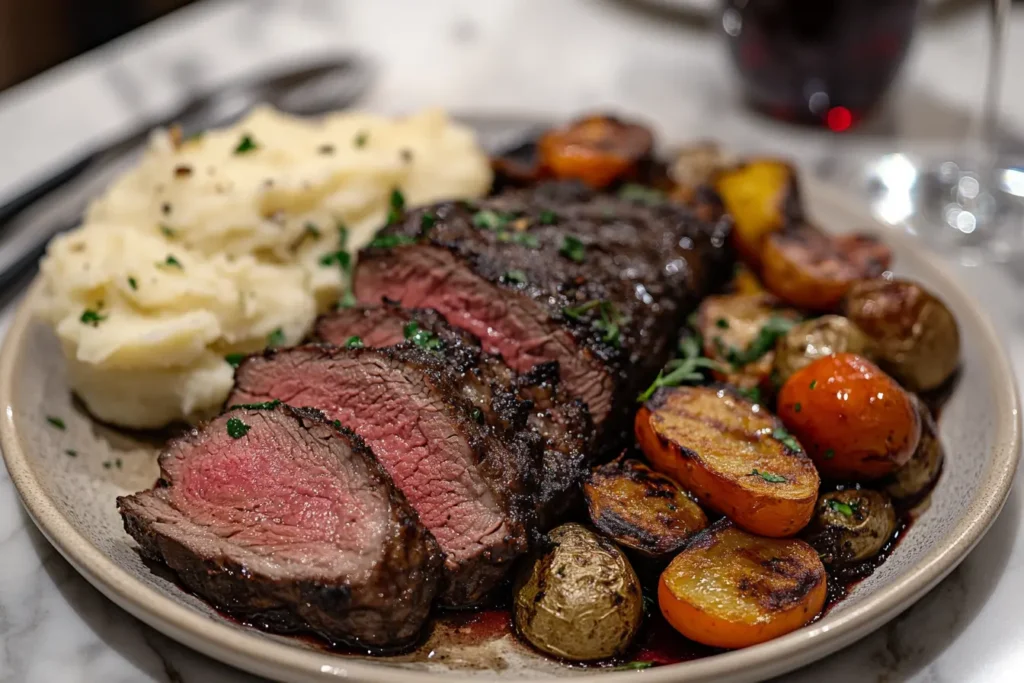
A perfectly cooked ribeye roast deserves equally delicious side dishes. Whether you prefer classic pairings or want to try something unique, these options will elevate your dinner experience.
Classic Pairings: Mashed Potatoes, Roasted Vegetables, and More
For a traditional steakhouse-style dinner, consider these timeless side dishes:
✔ Garlic Mashed Potatoes – Creamy, buttery, and rich, they complement the beef’s deep flavors.
✔ Roasted Brussels Sprouts – Their slight bitterness balances the roast’s fattiness.
✔ Honey-Glazed Carrots – A touch of sweetness enhances the savory meat.
✔ Yorkshire Pudding – This classic British side pairs wonderfully with roast beef.
✔ Creamed Spinach – Adds a velvety texture and a hint of indulgence.
Pro Tip: Serve your ribeye roast with a side of horseradish sauce or chimichurri for an extra flavor kick!
Low-Carb & Keto-Friendly Side Dishes
If you’re following a low-carb or keto diet, try these lighter sides:
✔ Cauliflower Mash – A delicious alternative to mashed potatoes.
✔ Grilled Asparagus – A simple yet elegant vegetable side.
✔ Sautéed Mushrooms – Their earthy flavor pairs beautifully with ribeye.
✔ Brussels Sprouts with Bacon – Adds a smoky, crispy element to your plate.
Wine and Sauce Pairings for Ribeye Roast
A good wine pairing enhances the flavors of the ribeye roast, creating a restaurant-quality dining experience at home.
Best Wines for Ribeye Roast
Since ribeye roast is rich and fatty, it pairs best with bold, full-bodied red wines:
- Cabernet Sauvignon – Its tannins cut through the fattiness, balancing the dish.
- Merlot – A softer option with fruity notes.
- Malbec – Offers a rich, smoky flavor that complements roasted meat.
- Syrah/Shiraz – Adds spicy undertones that enhance the beef’s depth.
Pro Tip: If you prefer white wine, go for an oaky Chardonnay—it pairs surprisingly well with beef!
Best Sauces for Ribeye Roast
While ribeye is flavorful on its own, a great sauce can elevate it even further. Try these:
✔ Red Wine Reduction – A classic sauce made with red wine, shallots, and butter.
✔ Peppercorn Sauce – A creamy, peppery complement to beef.
✔ Garlic Herb Butter – Melts over the roast, adding richness.
✔ Horseradish Cream – A tangy, slightly spicy sauce that cuts through the fat.
“A great wine pairing or sauce doesn’t overpower the meat—it enhances it.”
Storing and Reheating Leftover Ribeye Roast
Cooked a big roast and have leftovers? No worries! Proper storage and reheating will help maintain the flavor and texture of your ribeye roast.
Best Way to Store Leftovers
To keep your ribeye roast fresh:
✔ Refrigerate – Wrap slices tightly in foil or store in an airtight container. It stays fresh for 3-4 days.
✔ Freeze – Wrap in plastic wrap + aluminum foil and place in a sealed freezer bag. It lasts for 2-3 months.
Pro Tip: Slice the roast before storing for easier reheating.
How to Reheat Without Losing Flavor
The key to reheating ribeye roast is to avoid overcooking it. Here’s how:
1. Oven Method (Best for Large Portions)
- Preheat oven to 250°F.
- Wrap the roast in foil and heat for 15-20 minutes until warm.
2. Stovetop (For Quick Reheating)
- Heat a skillet over medium heat.
- Add butter or beef broth to keep it moist.
- Sear slices for 1-2 minutes per side.
3. Sous Vide (Best for Preserving Juiciness)
- Set a sous vide machine to 130°F (medium-rare).
- Seal slices in a ziplock bag and submerge for 20-30 minutes.
Avoid Microwaving! It dries out the meat and ruins the texture.
Frequently Asked Questions (FAQ)
Is a Ribeye Roast the Same as a Prime Rib Roast?
Not exactly. Both come from the same rib section, but prime rib is typically bone-in, while ribeye roast is usually boneless.
Is Ribeye Good for Roasting?
Yes! Ribeye is one of the best cuts for roasting because of its marbling and tenderness. The fat melts, keeping the meat juicy and flavorful.
Should I Sear a Ribeye Roast Before Cooking?
Absolutely! Searing locks in the juices and creates a delicious crust. If using the reverse-sear method, you’ll sear at the end of cooking for the best results.
What Temperature Should Ribeye Roast Meat Be?
The ideal internal temperature depends on your preferred doneness:
| Doneness | Temperature Before Resting | Final Temperature After Resting |
|---|---|---|
| Rare | 110-115°F | 120-125°F |
| Medium Rare | 120-125°F | 130-135°F |
| Medium | 130-135°F | 140-145°F |
| Medium Well | 140-145°F | 150-155°F |
| Well Done | 150-155°F | 160°F+ |
Pro Tip: Always let the meat rest for 30 minutes after roasting to lock in juices.
Conclusion: Enjoy Your Perfectly Cooked Ribeye Roast
Now that you’ve mastered the secrets of a perfect ribeye roast, it’s time to put them to the test. Whether it’s a holiday dinner or a cozy weekend meal, this recipe guarantees a juicy, flavor-packed roast that will have everyone coming back for seconds. So grab your favorite cut, fire up the oven, and enjoy the best ribeye roast you’ve ever made!
✔ Remember to slow-roast for tenderness.
✔ Use a thermometer to avoid overcooking.
✔ Pair with delicious sides and wine for an unforgettable meal.
Now, it’s time to fire up that oven and enjoy! 🍽️
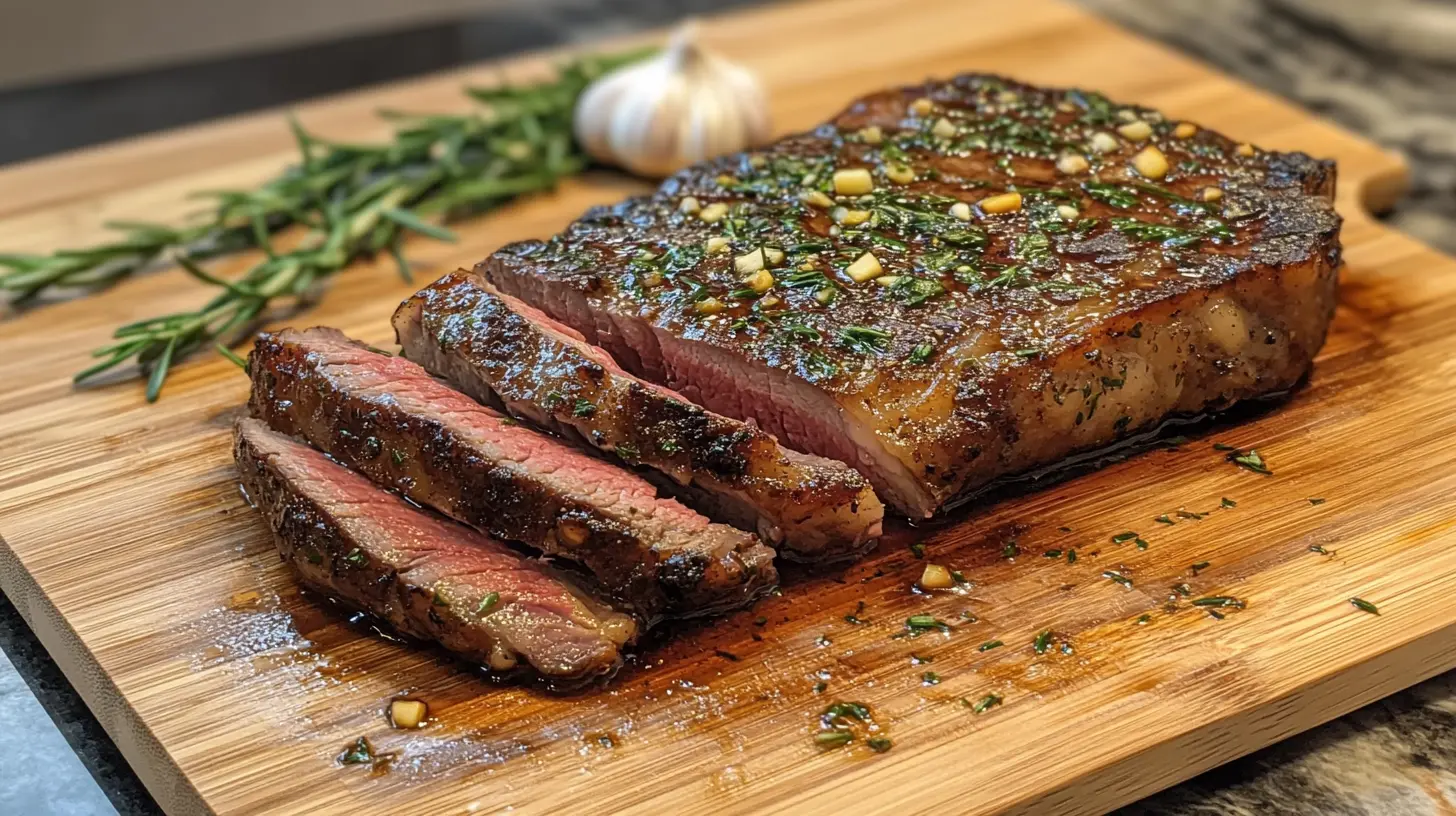
Ribeye Roast Recipe
Ingredients
Method
- Preheat oven to 225°F (107°C). A lower temperature ensures even cooking and prevents drying out.
- Pat the ribeye roast dry with a paper towel. Rub olive oil all over the meat.
- Generously coat with salt, black pepper, and garlic powder. Add fresh rosemary and thyme for extra flavor. Let sit for 30 minutes to absorb seasoning.
- Place the ribeye roast on a wire rack over a baking sheet. Insert a meat thermometer into the thickest part.
- Roast at 225°F until it reaches 10-15°F below your target doneness (see temperature guide).
- Once the roast reaches the desired temperature, remove it from the oven and let it rest for 30-45 minutes to allow juices to redistribute.
- Heat a cast-iron skillet over high heat. Melt butter in the pan.
- Sear the roast on all sides for 30-60 seconds per side until a beautiful golden-brown crust forms.
- Slice against the grain and serve immediately with your favorite side dishes.
